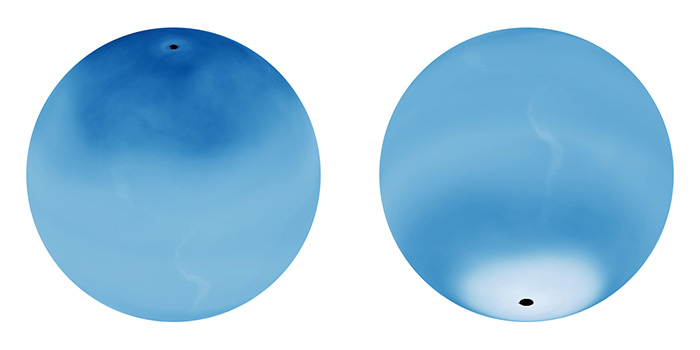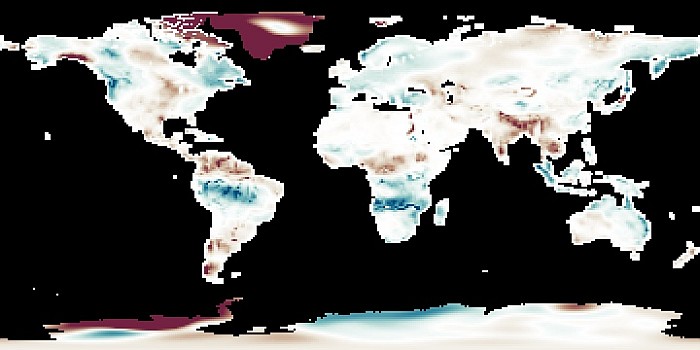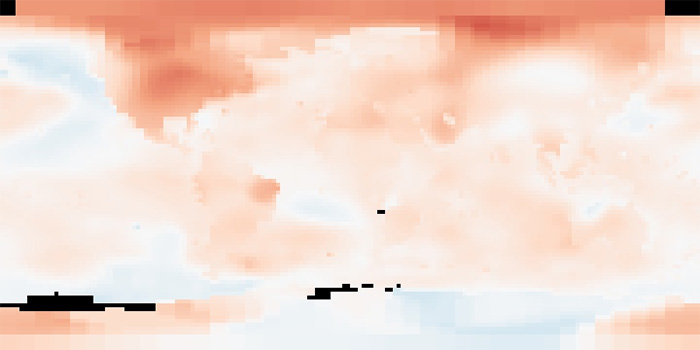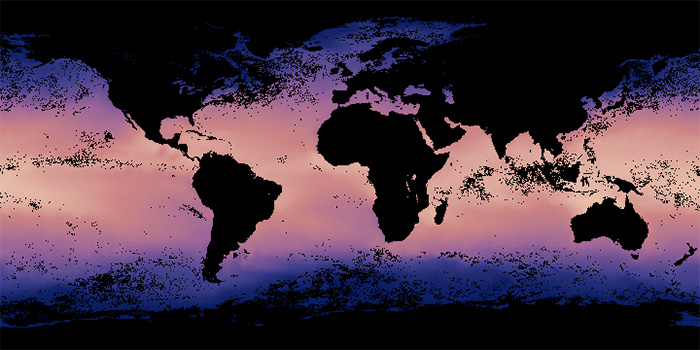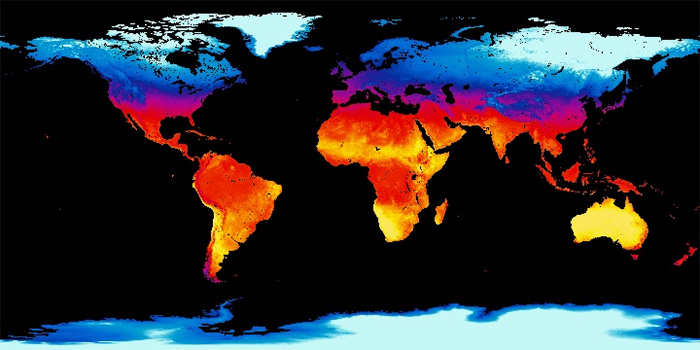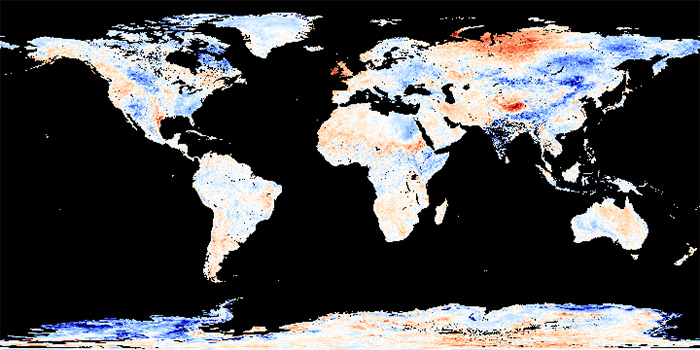NEO News
New Dataset: Ozone
June 12th, 2012 by Kevin Ward
The Ozone Monitoring Instrument (OMI) on NASA’s Aura satellite provides measurements of total column ozone, which is how much ozone is present in a column of the atmosphere stretching from the surface to the top of the atmosphere. Therefore, it includes both ground-level and stratospheric ozone. Ground-level ozone is especially common in industrialized areas during the summertime, and winds can blow ozone from urban areas into neighboring areas. Stratospheric ozone, however, absorbs harmful ultraviolet radiation known as UV-B. Because of stratospheric ozone’s protective function, the “ozone hole” over Earth’s southern polar region has concerned scientists since the late 1970s.
NEO now provides daily, weekly, and monthly composites of total column ozone from October 2004 to present.
View the complete collection and read more about ozone on NEO.
Comments Off on New Dataset: Ozone
New Dataset: Water Equivalent Anomaly
June 29th, 2011 by Kevin Ward
These maps show how water stored on and in the land changes from month to month. The maps are blue where there is more water than average and red where there is less water. Water accumulates on land in rivers and lakes, as ground water and soil moisture, and as snow and ice. Scientists track water both to understand the water cycle and to monitor the availability of fresh water. The maps show that water levels change throughout the year with the seasons. Changes from year to year may reveal drought or an excess of water. These data currently include monthly composites from April 2002 to present.
View the complete collection and read more about water equivalent anomaly on NEO.
Comments Off on New Dataset: Water Equivalent Anomaly
New Dataset: Global Temperature Anomaly
April 11th, 2011 by Kevin Ward
These maps depict how much warmer or colder a region may be in a given month compared to the norm for that same month in the same region from 1951-1980. These maps do not depict absolute temperature but instead show temperature anomalies, or how much it has changed. These data currently include annual and monthly composites from January 1880 to present.
View the complete collection and read more about global temperature anomaly on NEO.
Comments Off on New Dataset: Global Temperature Anomaly
Exploring the Role of Snow Cover in Shaping Climate with NEO
November 12th, 2010 by Kevin Ward
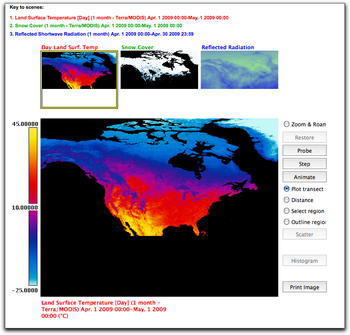
In this chapter from the Earth Exploration Toolbook, you can investigate satellite images displaying land surface temperature, snow cover, and reflected shortwave radiation data from NEO.
Download, explore, and animate these images using ImageJ, a public domain image analysis program from the National Institutes of Health (NIH). Then use the web-based analysis tools built into NEO to observe, graph, and analyze the relationship between the three variables.
Comments Off on Exploring the Role of Snow Cover in Shaping Climate with NEO
NEO is now on Facebook
November 10th, 2010 by Kevin Ward
Now you can also follow the action on Facebook! Hope to see you there: https://www.facebook.com/NASAEarthObservations
Comments Off on NEO is now on Facebook
New Dataset: Sea Surface Temperature 1981-2006 (AVHRR)
August 4th, 2010 by Kevin Ward
Sea surface temperature is the temperature of the top millimeter of the ocean’s surface. Sea surface temperatures influence weather, including hurricanes, as well as plant and animal life in the ocean. Like Earth’s land surface, sea surface temperatures are warmer near the equator and colder near the poles. Currents like giant rivers move warm and cold water around the world’s oceans. Some of these currents flow on the surface, and they are obvious in sea surface temperature images. These data are collected by an ongoing series of National Oceanic and Atmospheric Administration (NOAA) satellites as part of the NOAA/NASA Advanced Very High Resolution Radiometer (AVHRR) Pathfinder Program.
View the complete collection and read more about this dataset on NEO.
Comments Off on New Dataset: Sea Surface Temperature 1981-2006 (AVHRR)
New Datasets: Average Land Surface Temperature and Anomaly
February 19th, 2009 by Kevin Ward
We have four new datasets that have just been added to the collection:
Land surface temperature is how hot the ground feels to the touch. If you want to know whether temperatures at some place at a specific time of year are unusually warm or cold, you need to compare them to the average temperatures for that place over many years. These maps show the average weekly or monthly, daytime or nighttime land surface temperatures for 2001-2010.
An anomaly is when something is different from average. These anomaly maps show where Earth’s surface was warmer or cooler during the day or night than the average temperatures for the same week or month from 2001-2010. For example, a daytime land surface temperature anomaly map for May 2002 would show how that month’s daytime temperature was different from the average temperature for all Mays between 2001 and 2010.
Comments Off on New Datasets: Average Land Surface Temperature and Anomaly
New Dataset: Solar Insolation
May 30th, 2008 by Kevin Ward
These maps show where and how much sunlight fell on Earth’s surface during the time period indicated. Scientists call this measure solar insolation. Knowing how much of the Sun’s energy reaches the surface helps scientists understand weather and climate patterns as well as patterns of plant growth around our world. Solar insolation maps are also useful to engineers who design solar panels and batteries designed to convert energy from the Sun into electricity to power appliances in our homes and work places.
NEO now provides daily, weekly, and monthly composites of total column ozone from July 2006 to present.
View the complete collection and read more about global temperature anomaly on NEO.
Comments Off on New Dataset: Solar Insolation
NEO Web Mapping Service (WMS)
April 25th, 2007 by Kevin Ward
The NEO Web Map Service implementation strives to open up the NEO collection to users who wish to access its contents via machine-to-machine interaction. WMS gives users the ability to access maps from any implementing service using a standardized programming interface.
Comments Off on NEO Web Mapping Service (WMS)
- Browse by Topic
- Analysis
- NEO in the Media
- New Datasets
- Services
- Uncategorized
- Browse by Date
- August 2024
- May 2023
- April 2021
- February 2021
- December 2020
- November 2020
- October 2020
- September 2020
- June 2019
- March 2019
- April 2015
- April 2014
- December 2013
- November 2013
- August 2013
- March 2013
- June 2012
- June 2011
- April 2011
- November 2010
- August 2010
- February 2009
- May 2008
- April 2007















![Average Land Surface Temperature [Day]](/images/datasets/132x66/MOD_LSTD_CLIM_M.jpg)
![Average Land Surface Temperature [Night]](/images/datasets/132x66/MOD_LSTN_CLIM_M.jpg)


![Land Surface Temperature Anomaly [Day]](/images/datasets/132x66/MOD_LSTAD_M.jpg)
![Land Surface Temperature Anomaly [Night]](/images/datasets/132x66/MOD_LSTAN_M.jpg)
![Land Surface Temperature [Day]](/images/datasets/132x66/MOD_LSTD_M.jpg)
![Land Surface Temperature [Night]](/images/datasets/132x66/MOD_LSTN_M.jpg)



























